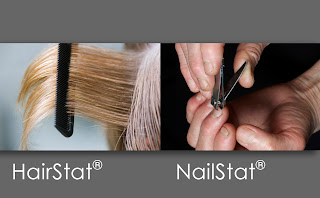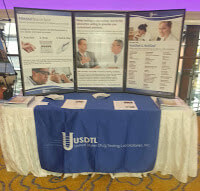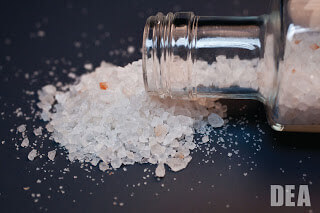Laboratory Announces Improvements in Testing Hair And Nail For Substances of Abuse.
Showing: Inc.
For Release Immediately
December 31st, 2012
 DES PLAINES, IL— HairStat® / NailStat®Improved Cutoffs — Today, United States Drug Testing Laboratories, Inc. announced that they will introduce lower substances of abuse screening and confirmation cutoffs for hair and nail specimens.
DES PLAINES, IL— HairStat® / NailStat®Improved Cutoffs — Today, United States Drug Testing Laboratories, Inc. announced that they will introduce lower substances of abuse screening and confirmation cutoffs for hair and nail specimens.
Positive Customer Impact
Many customers have already benefited from using USDTL as a laboratory that can customize drug testing to suit their needs. The improvement of the cutoffs means that customers can now have a wider range of detection for certain substances of abuse, and can be assured that they are receiving positive drug screen confirmations not currently available at market place. The breadth and sensitivity of the profiles make these tests more effective.
HairStat® / NailStat® Availability
These improvements in HairStat and NailStat are driven by USDTL’s ongoing commitment to be a leader in alcohol and substances of abuse detection. These cutoffs will be effective for hair and nail specimens received at USDTL on or after January 2nd, 2013.
Established in 1991 as a specialty drug testing facility, United States Drug Testing Laboratories, Inc. quickly became a leader in the industry. They have made significant breakthroughs by developing procedures to effectively use specimens to diagnose alcohol and substance misuse and abuse. They offer a wide range of testing services and specialize in hard to detect substances of abuse and customized assays.
For more information please visit http://www.USDTL.com
###
USDTL, HairStat®, NailStat® are trademarks of Unites States Drug Testing Laboratories, Inc. in the United States and/or other countries.
For more information on HairStat® or NailStat®:
Video links from “The Doctors” re: Newborns Exposed to Drugs And Alcohol in The Womb.
 Methamphetamine Babies
Methamphetamine Babies
Registered nurse Linda West and fellow Angels in Waiting nurses join The Doctorsto share their experiences fostering abandoned methamphetamine babies. OB/GYN Dr. Lisa Masterson explains how using methamphetamine while pregnant affects a growing fetus.
Angels In Waiting
More than 550,000 babies are born every year after exposure to drugs and alcohol in the womb. These babies are often born premature and with serious health issues, which make them “unpopular” for adoption. Registered nurse Linda West took matters into her own hands and founded the organization Angels in Waiting, a network of neonatal intensive care unit nurses who become foster parents for abandoned babies
How We Can Help
USDTL CordStat® definitively confirms opioid exposure. Many NAS babies are poly-substance exposed in utero. CordStat 12 and 13 drug panels identify the majority of opioids along with many drugs often associated with NAS. Positive results are an objective measure and often times the only flag that baby’s home life may need extra care. Go to www.USDTL.com to learn more.
 Q: Is there a test that can differentiate between fetal exposure to heroin and fetal exposure to morphine during the birthing process?
Q: Is there a test that can differentiate between fetal exposure to heroin and fetal exposure to morphine during the birthing process?
A: Yes. The umbilical cord tissue or meconium from a baby whose mother was administered morphine during delivery will only be positive for morphine. The umbilical cord of a baby that is positive for Meconin and/or Monoacetylemorphine (6-MAM) in addition to morphine is indicative of heroin exposure.
Knowing the difference can help doctors and nurses provide a better outcome for baby’s treatment plan.
USDTL now offers a sensitive test for Meconin which is helpful in determining exposure to heroin. Visit www.USDTL.com – testing services for information on umbilical cord testing or contact client services at 800-235-2367.
 Q: What is Meconin and why is it important in newborn toxicology?
Q: What is Meconin and why is it important in newborn toxicology?
A: Morphine is the predominant metabolite of heroin, but morphine is also a stand alone drug and a metabolite of codeine. Some mothers are provided morphine during delivery. Historically, there have been instances where heroin using moms could not be distinguished from moms given morphine during delivery. Meconin is a contaminating constituent from poppy that is present in heroin. Therefore, like Monoacetylmorphine – a metabolite of heroin, the presence of Meconin indicates the use of heroin and when found in newborn specimens indicate fetal exposure to heroin.
USDTL offers Meconin testing in both umbilical cord tissue and meconium.
Click here to find out more about our testing services
Why USDTL requires Forensic Specimen Handling for all but research projects
 As you know, the primary specimen handling issues that differentiate a forensic from a clinical toxicology specimen are:
As you know, the primary specimen handling issues that differentiate a forensic from a clinical toxicology specimen are:
* securing the specimen with a tamper-evident seal
* a documented chain of custody.
A positive test result may do more than affect the newborn’s treatment. Today, a further consequence of a positive newborn toxicology report may involve intervention by the State due to a significant number of jurisdictions requiring reporting of all positive newborn toxicology results. In some instances, these positive results may ultimately lead to termination of parental rights. Therefore, it is very important that all newborn specimens be handled as if they may be litigated. It is this distinct possibility of litigation that is the driving force behind USDTL’s requirement for proper chain-of-custody handling. It is also the reason why CAP-accredited laboratories follow forensic procedures in all areas including newborn toxicology services.
The minimum criteria to ensure the integrity of the chain-of-custody for a specimen is the presence of an intact tamper-evident seal and the signature and date of the collector or the individual that prepared the specimen for send out. A tamper-evident seal is supplied with each USDTL Chain-of-Custoday and Control Form for your convenience. Our concern is in the best interests of our smallest patients.
 USDTL attends upwards of fifty conferences a year. It is our way of supporting the communities we serve and touching base with clients old and new.
USDTL attends upwards of fifty conferences a year. It is our way of supporting the communities we serve and touching base with clients old and new.
The month of October is an extraordinary time for us. We will have personnel at nine conferences.
Starting Tuesday, October 9, Kendyll Vanzandt, Client Services Representative will be in Grand Rapids, Michigan at the Amway Grand Hotel for the annual CoLap conference.
Thursday, October 11, Gary Bohl, Forensic Account Executive, will be in Newport Beach for the West Coast Behavioral Health and Addiction Disorders conference.
Saturday, October 13, Douglas Lewis, USDTL President and Scientific Director, and Victoria Lewis Marketing Sales Associate, will be in Washington, D.C. for the ASA meeting.
Monday, October 15, Bob Demaree, Clinical Projects Manager, will be in Florida at the FANNP conference.
Wednesday, October 17th, Kendyll will be at NANN in Palm Springs and Bob will join her on the 18th.
Thursday, October 18th, Gary will be at TAAP in Houston, TX.
Wednesday, October 24th, Douglas and Victoria Lewis will be at CCLMA in Chicago.
Thursday, October 25th, Gary Bohl will be at his first international show, AMA, CMA, BMA International in Montreal, CA.
Sunday, October 28th, Bob will be at the Fetus and Newborn conference, talking to clients about our CordStat panels.
It’s a busy month. We are proud to serve. If you are at any of these shows, please drop by and say hello.
 Q: I received a report that says “REJECTED” and “Profile not indicated- fax request to lab”. What does that mean? Has the specimen been destroyed? What should I do?
Q: I received a report that says “REJECTED” and “Profile not indicated- fax request to lab”. What does that mean? Has the specimen been destroyed? What should I do?
A: One piece of information that must be present on the Requisition Form is the Test Profile Requested. The lab is not allowed to pick and choose which panels to run on your behalf. We must obtain that information from the client in writing.
If the requisition form does not indicate which test to run, we reject the specimen with a request for the client to notify USDTL which profile to run on the specimen. You may notify the lab of the test profile you desire by fax or email. Remember to include multiple pieces of identification on the request. One fail-safe and quick way to notify the lab of which test to run is to note the desired profile on your fax copy and fax that over to the lab.
These specimens are retained for at least one week. Specimen requests not resolved within one week are scheduled for destruction along with the week-old negative specimens. One alternative to consider is the selection of a “Default Profile”. Having this information documented and on file at the laboratory allows the laboratory to assign a default profile when one is not indicated on the Requisition Form.
 Smiles – new killer drug
Smiles – new killer drug
http://shine.yahoo.com/healthy-living/2c-smiles-killer-drug-every-parent-know-234200299.html
What parents need to know about new drug trends in kids: Glass cleaner, bath salts and “Skittle parties” … http://bit.ly/RkOrfe
Rampant abuse of alcohol and prescription drugs in the military http://bit.ly/T4qnEa
Baby Boomers Rediscovering Old #Addictions –http://ow.ly/dLUpS
 Officials in #Russia concerned about new synthetic #marijuana called “spice:” apne.ws/MOdQRp @AP
Officials in #Russia concerned about new synthetic #marijuana called “spice:” apne.ws/MOdQRp @AP
Painkiller abuse linked to #depression & #suicide in college students: ow.ly/c4ro3
Evidence mounts: Methadone Risky in Chronic Pain:http://www.medpagetoday.com/PublicHealthPolicy/PublicHealth/33611
http://www.reuters.com/article/2012/07/03/us-usa-health-painkillers-idUSBRE8620UH20120703
Almost 1500 packages of synthetic drugs seized in Illinois: LegalNewsline – Almost 1500 packages of synthetic dr… bit.ly/NtEM5R
On an avg day in June or July, more than 4,800 youths used marijuana for the first time 1.usa.gov/PlluUb
On an avg day in June or July, more than 5,000 youths smoked cigarettes for the first time 1.usa.gov/PlluUb
On an avg day in June or July, more than 11,000 youths used alcohol for the first time 1.usa.gov/PlluUb
Prescription Drug Abuse Among Pregnant Women:
http://rockcenter.msnbc.msn.com/_news/2012/07/05/12570381-prescription-drug-addiction-among-pregnant-women-becoming-monstrous-tidal-wave?lite
Addicted Mom on Baby’s Withdrawl; It’s All My Fault:
http://www.msnbc.msn.com/id/21134540/vp/48085618#48085618
Prescription Pill Epidemic Impacts Babies:
http://www.msnbc.msn.com/id/21134540/vp/48081187#48081187
- Umbilical Cord Tissue Testing for SSRIs
- A Comparison of Turnaround-Times for Two Popular Specimen Types Used for Newborn Toxicology: Meconium and Umbilical Cord Tissue
- Using Umbilical Cord Tissue to Identify Prenatal Ethanol Exposure and Co-exposure to Other Commonly Misused Substances
- Toxicology as a Diagnostic Tool to Identify the Misuse of Drugs in the Perinatal Period
- Specimen Delay
- Drug Classes and Neurotransmitters: Amphetamine, Cocaine, and Hallucinogens
- Environmental Exposure Testing for Delta-8 THC, Delta-9 THC, Delta-10 THC, and CBD
- Bromazolam and Synthetic Benzodiazepines
- October 2024 (5)
- March 2024 (1)
- February 2024 (1)
- January 2024 (3)
- December 2023 (1)
- November 2023 (1)


